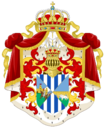Montemor
| Kingdom of Montemor Reino de Montemor (Portuguese) | |
|---|---|
| Capital | Montemor |
| Official languages | Portuguese |
| Religion(2023) | Predominantly Roman Catholicism |
| Demonym | Montemorian |
| Government | constitutional monarchy |
• King | Tobias Requiao |
• Chancellor | vacant |
| Formation 06 January 2023 | |
| Population | |
• 2023 estimate | 3 |
| Currency | a |
| Date format | dd/mm/yyyy |
| Drives on the | left |
| |
Montemor, officially the Kingdom of Montemor (Portuguese: Reino de Montemor) is an enclaved micronation located in Europe, bordering Portugal. Portuguese is the official language. English is recognized as a diplomatic language. In 2023, the micronation was created proclaiming its independence from Portugal. Montemor Constitution was formulated based on Portuguese Constitution of 1838 and the Charter of 1830 and the state was defined as a constitutional monarchy.
Etymology
The name Montemor came to be used due to an existing hill at the site. This mountain was the largest in the region and that is why it became known as Monte Mor.
History
Geography
Politics
The Kingdom of Montemor is defined as a constitutional monarchy.
Economy
Infrastructure
Science and technology
Transport
Education
Health
Demographics
Religion
Languages
Culture
The core culture of Montemor is derived from Portuguese culture.
Culinary
Montemorian cuisine is greatly influenced by Portuguese cuisine. And some typical dishes made with lamb stand out.
- Roasted lamb
- Montemorian veal
- Lamb (young ram)
- Sausage rice
- Corn bread
- Sausages
- Montemuro Honey
Castanhada

Castanhada (or Magusto) is a traditional popular festival, where people gather around a fire to roast chestnuts. It is always held on Saint Martin's Day, on November 11th.
Geography
Flora and fauna
The flora of Montemor (as well as the Serra de Montemuro where the principality is located) is quite rich. On the slopes of the mountain, but practically at the bottom of the mountain, pine (Pinus pinaster) plantations predominate, accompanied by oak or oak (Quercus robur) and chestnut (Castanea sativa). There is also shrubby vegetation, where gorse (Ulex spp) and heather predominate, such as red heather (Erica australis), white heather (Erica arborea), queiró (Erica umbellata), white sargassum (Cistus psilosepalus) , white broom or mountain broom (Cytisus multiflorus), and ferns (Asplenium spp.). The carqueja (Pterospartum tridentatum) is found more frequently on the south side where it can occupy large spaces. Tree species vary depending on the geological formation, such as holly (Ilex aquifolium), which is a rare and protected species, alder and willow.
The main threat factors for fauna and flora (mainly due to the lack of supervision by the Portuguese State) are:
- Fire is one of the factors in the degradation of forest areas, causing serious damage to vegetation.
- Fires, used systematically and incorrectly, also lead to the destruction of spontaneous vegetation cover, favoring erosion and the disappearance of characteristic biotopes.
- The collection of botanical species by collectors (the rarest) and by laboratories (those of a medicinal nature).
- Overgrazing, practiced by goat cattle, compromises the regeneration of some species of native vegetation.
- Poaching is carried out through illegal means, with game and non-game species being eliminated.
- The use of protected areas for off-road trails damages the vegetation cover.
Main animals found in Montemor:
- wolf (Canis lupus) - Rare
- wild boar (Sus scrofa) - Rare
- fox (Vulpes vulpes) - Rare
- Horned viper (Vipera latastei) - Rare and poisonous
- partridges (Alectoris rufa)
- woodcocks (Scolopax rusticola)
- round-winged eagle (Buteo buteo)
- black blackbird (Turdus merula)
- eared owl (Otus scops)
- common finch (Fringilla coelebs)
- black starling (Sturnus unicolor)
- common nightingale (Luscinia megarhynchos)
- shrews (Crocidura sp.)
- the European rabbit (Oryctolagus cuniculus)
- badger (Meles meles)

